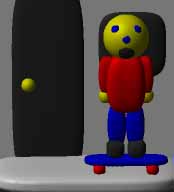Larry
Osterman comments on The
Graphing Calculator Story
It's an "interesting" story, and I have to say that I
was aghast when I read it. And my jaw dropped even further when
I read the Digg comments about it....
For some reason, the people reading the story actually thought it
was COOL!
Now think about it. These people were so dedicated to their
product that they were willing to BREAK THE LAW to get it into
Apple's OS....
Apple CANCELED their project. Apple made an executive decision to
not produce the product.
And the developers decided to override it by BREAKING INTO APPLE.
There are a bazillion other ways they could have handled it:
Building it on their own and trying to convince Apple to put it in
the product, etc. But no, they chose to STEAL from Apple.
And the policies of Apple were sufficiently lax that they let
them get away with it.
The discussion going on the comments on Larry's blog is a fascinating
consideration of the ethics of the situation. I find myself largely sympathetic to his reaction. He is not wrong.
I am still tickled by the ethical ambiguity. It is only
trespassing if we did not have permission. We were given permission
later, retroactively making it legitimate. But there was no way we
could know that at the time. I certainly told myself that we were
"doing the right thing" and believed that. But at the same time, I
was self-aware enough to realize that that was just frustration and
bull-headedness and my ego talking. Even looking back it now, I'm
still not sure if I pulled one over one them, or if I was horribly
naive and taken advantage of, or perhaps both.
I was certainly arrogant to think that I knew what was in Apple's
best interest. Had I been arrested I would have accepted the
consequences knowing I had earned them. Yet, when we came clean with what
we had been doing, management confirmed my judgment and agreed that
it was worthwhile and ought to ship.
We could not have done any of this without the support of a lot of
people who knew us, trusted us, and helped us at every step along the
way. We were not strangers breaking in during the dark of night. Our
behavior arose out of the chaos and culture of Apple at the time.
The events are 13 years old. I wrote the story 10 years ago, but
did not publish until 2 years ago, waiting until Apple was no longer
"beleaguered" and the story could be read as an amusing history
rather than a reflection on Apple today. The Apple of 1993 was
entirely unlike the Apple of today. Nothing like this would happen
there today - nor would there be any need or desire to operate that
way in what is now a healthy and well-managed company.
I invite folks who were at Apple in that era to reminisce about
the culture and the chaos.



 Consider the Calculator Desk Accessory on the original 1984
Macintosh System 1.0. It is easy to use and easy to learn. The
interface is self-revealing: it requires no documentation and no
instruction. It is obvious at a single glance both what it is capable
of doing and how to do it. Equally importantly, its limitations are
as obvious as its functionality. No one will waste any time trying to
coax it to do anything which it was not designed to do. Every
designer should strive towards these qualities.
Consider the Calculator Desk Accessory on the original 1984
Macintosh System 1.0. It is easy to use and easy to learn. The
interface is self-revealing: it requires no documentation and no
instruction. It is obvious at a single glance both what it is capable
of doing and how to do it. Equally importantly, its limitations are
as obvious as its functionality. No one will waste any time trying to
coax it to do anything which it was not designed to do. Every
designer should strive towards these qualities.